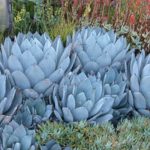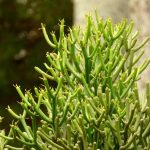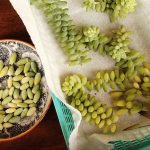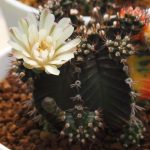Discover the captivating Euphorbia myrsinites, a stunning xeriscape plant that requires careful management to prevent invasiveness. Explore our expert tips here.
The charming Euphorbia myrsinites flaunts striking blue-green leaves and delightful chartreuse to bright yellow bracts on sprawling stems. Blooming primarily in early spring, this plant hails from Asia Minor and Southeastern Europe.
Also known as Myrtle Spurge or Donkey Tail, this perennial succulent, part of the Euphorbiaceae family, can be either annual or perennial depending on the climate. It has earned the prestigious Royal Horticultural Society’s Award of Garden Merit.
Euphorbia myrsinites is renowned for its invasive tendencies in some regions, leading to its prohibition in select US states. Despite this, it remains a valuable addition for xeriscaping projects.
Quick Care Guide

| Common Name(s): | Donkey tail spurge, myrtle spurge, blue spurge, creeping spurge |
| Scientific Name | Euphorbia myrsinites |
| Family: | Euphorbiaceae |
| Zone: | 5-9 |
| Height & Spread: | 6-12″ tall and wide |
| Light | Full sun |
| Soil | Normal, sandy soil |
| Water: | Low |
| Pests & Diseases: | Aphids, mealybugs |
All About Euphorbia Myrsinites

In the UK, the Royal Horticulture Society acknowledges Euphorbia myrsinites for its exceptional beauty. These succulents grace rock gardens, terracotta pots, or driveways, showcasing a stunning ground cover.
Hailing from Southeastern Europe and Asia Minor, the plant’s gray-green spiraled leaves add to its allure. Blooming with inconspicuous greenish flowers that transform into small sulfur-yellow blossoms, it’s a favorite for its showy yellow bracts.
While acclaimed by the Royal Horticulture Society, cautious cultivation is advised due to its invasive nature in Oregon, Utah, and Colorado. To prevent ecological harm, plant in containers, remove spent flowers promptly, and monitor growth boundaries to contain its spread.
Displaying typical Euphorbia traits, this species exudes a latex sap that can cause skin irritation and is toxic if ingested, posing risks of blindness if in contact with eyes. Protective gear like goggles, gloves, and long-sleeved attire is crucial when handling Euphorbia myrsinites.
Myrtle Spurge Care

Despite its dangers, caring for myrtle spurge is relatively straightforward as long as it’s managed effectively. Let’s delve into the essentials now.
Light & Temperature
Thriving in full sun, this plant favors USDA hardiness zones 5 to 9. While ideal outdoors, for areas where it’s problematic, or in colder climates, indoor cultivation near a sunny south-facing window is an alternative.
Its adaptability to both high triple-digit temperatures and lows down to -20°F contributes to its invasiveness. Established plants require no special protection from extreme climate conditions, yet flourish in warmer winter climates.
Water & Humidity
Drought-tolerant, this succulent demands minimal watering to thrive. Avoid over-watering, as it can prove fatal. Water sparingly, ensuring the soil dries up to a finger’s length before watering, especially during severe droughts. Avoid excessive humidity to prevent water-related issues.
Watering Euphorbia Myrsinites
When watering your plant, wet the leaves and water slow and low in the morning whenever possible.
Soil
Well-draining sandy or gravelly soil suits your plant best, avoiding overly nutritious soil. For enhanced drainage, mix coarse gravel or sand with pre-formulated cactus soil.
Fertilizer
Fertilizer is usually unnecessary for this plant, especially in areas where it thrives in low-quality soils. Avoid fertilizing in regions where it’s classified as an invasive species.
Repotting Euphorbia Myrsinites
When repotting, move your plant to a slightly larger container with proper drainage if it outgrows its current one. Use coarse potting mix and ensure your plant remains at the same level during the transfer. Water lightly and place in full sun to establish new roots.
Myrtle Spurge Propagation
Propagate your plant through seeds or cuttings during the growing season. Wear protection when handling the plant due to its saponin content. Dip cuttings in rooting hormone and plant in coarse potting mix for successful root development within weeks.
Pruning Your Euphorbia
Prune your Euphorbia myrsinites after blooming to control its invasive nature. Trim back stems and remove spent flowers before they disperse seeds. Clip yellowing blooming stems to maintain plant health.
Troubleshooting Euphorbia Myrsinites
Growing Problems
Manage your plant’s growth to prevent overtaking your garden by timely pruning. Avoid over-watering to prevent root rot and ensure plant longevity.
Pests
Combat pests like aphids and mealybugs with water blasts and organic treatments. Maintain well-drained soil to deter infestations and maintain plant health.
Diseases
Prevent bacterial and fungal rots by planting in well-drained soil and avoiding overly moist conditions. Treat root rot promptly by removing affected parts and adjusting watering practices.
Frequently Asked Questions
Q: When should I prune my Euphorbia plants?
Prune blooming stems as they turn yellow.
Q: Where do Donkey Tail plants grow?
These plants thrive in various environments, contributing to their invasive status in certain regions.
Q: Are Myrtle spurge plants poisonous?
All plant parts are toxic, requiring protective gear during handling.
Q: Is myrtle spurge invasive?
Yes, it’s classified as a noxious weed in certain states.
Q: How do I get rid of myrtle spurge?
Control spread by deadheading and relocating plants if required.
Q: What does myrtle spurge look like?
It’s an evergreen succulent with a sprawling growth habit and yellow flowers.
Q: Where does myrtle spurge grow?
Native to regions of the Mediterranean, it adapts to dry conditions globally.
Q: What happens if you touch spurge?
Minor skin irritation or blistering may occur upon contact.






